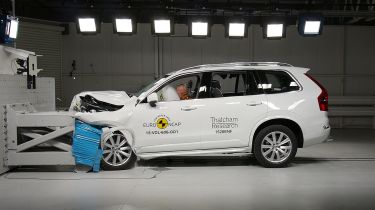What is Euro NCAP?
The European car crash-testing system explained

Euro NCAP is the common name for the European New Car Assessment Programme, a car safety body primarily concerned with crash-testing new cars for the European market.
Formed in 1996 and based in Leuven, Belgium, the organisation's members include the UK government's Department for Transport (DfT) and equivalents from across Europe, along with motoring clubs like the German ADAC, research organisations including Thatcham and motorsport's governing body, the FIA. A number of these members provide testing facilities, too.
Euro NCAP doesn't test every car on sale – rather, the organisation picks the most popular cars on the market. Retests of models that receive significant safety updates are also common. Each of the organisation's members is allowed to sponsor the assessment of at least one car each year, while car manufacturers can sponsor tests of their own cars.
Once a car is put forward for testing, Euro NCAP determines which version of that model is most popular, and what safety kit is fitted, to then pick a representative example. In some cases, a standard version of a car will be selected along with one fitted with a 'Safety Pack' – that is, a suite of driver assistance and/or active safety features commonly fitted to the model in question. Sometimes, this can result in two different ratings being awarded to a specific model of car: one with and one without the Safety Pack fitted.
Euro NCAP says it needs up to four examples of a car for its crash tests. These are generally bought anonymously from dealers if the car is on sale, but in other cases early production cars are selected at random from the production line or a manufacturer-provided list.
On its website, the organisation points out that it doesn't "test vehicles that are not fully type approved, are not from series production or not legally sellable to the general public".

Euro NCAP crash tests
Euro NCAP assesses cars across four broad categories: Adult Occupant Protection, Child Occupant Protect, Vulnerable Road User Protection and Safety Assist. All require physical testing with the real cars detailed above.
A percentage score for each of the four above categories is awarded, as well as an overall 'star rating', ranging from zero to five. Five stars has become the accepted norm, but as Euro NCAP tightens its criteria all the time, four-star ratings are not uncommon, particularly for smaller or cheaper cars.
Because of those ever-tightening criteria, Euro NCAP ratings from different years are not always directly comparable: a five-star car from 2015, for example, is not exactly as safe as a five-star car from 2020. However, Euro NCAP does conduct annual reviews of popular models' scores, sometimes lowering a score to reflect higher standards or improved technology that have come in since the initial test.
The Adult Occupant Protection rating is established with a range of tests including frontal, lateral and rear impact tests, along with a test that assesses how easily occupants can be rescued from a car following an incident. Euro NCAP's tests, performed using its famous dummies in place of human occupants, comprise cars being launched into walls, poles and deformable moving barriers (to simulate another car) at predetermined speeds and angles – all of which helps to paint a picture of a car's performance in an accident.
Child Occupant Protection ratings are collated via the assessment of a car's ISOFIX points, as well performance of recommended child restraint systems (car seats or booster seats) in a number of the above crash tests. Euro NCAP also tests to see how easy it is to fit some commonly used child seats.
Vulnerable Road User Protection tests are performed to figure out how pedestrians and cyclists fare in collisions with the car in question. The likely severity of head, upper leg and lower leg injuries are assessed using a dummy, while dummy pedestrians and cyclists are used to assess the functionality of any pedestrian-specific autonomous emergency braking (AEB) system fitted.
AEB performance in traffic is tested under the Safety Assist category; in 2020, Euro NCAP combined its previously separate testing for low and high-speed functionality, as well as adding a test scenario that involves the test car turning across the path of another vehicle. Euro NCAP uses a 'Global Vehicle Target' as an obstacle, specifically designed to test the all-important sensors for a car's active safety systems.
Most Popular

EV Deal of the Day: Dacia Spring is amazingly good value at £116 per month

